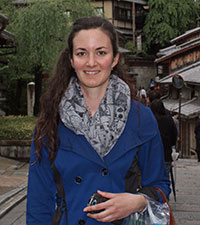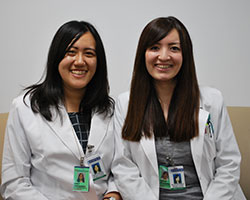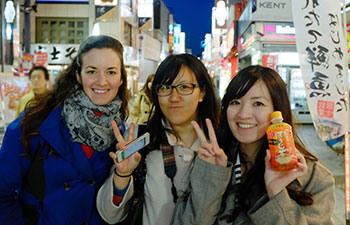

Exchange Program Bridges Cultures and Customs
International Exchange Programs Beam Einstein Students To Different Worlds
Gene Roddenberry, creator of the original Star Trek television series, predicted,“If man is to survive, he will have learned to take a delight in the essential differences between…cultures.” Alena Janda, an Einstein M.D.-Ph.D. candidate studying infectious diseases and immunology, recently had a chance to test Mr. Roddenberry’s hypothesis: She spent last April as an exchange student at Saitama Medical University (SMU), located about 12 miles northwest of Tokyo, Japan.

Alena Janda, in Saitama, JapanThe Japan Exchange Program is one of several International Exchange Programs (IEPs) through which the College of Medicine partners with respected medical institutions abroad (other sites include France, Israel and Sweden) to offer medical students in their fourth year of medical studies opportunities to observe how medicine is practiced in other cultures and to experience the people, customs and other unique features of their host countries.
“Exchange programs are a way for our students to enhance their medical education,” said Dr. Stephen Baum, senior associate dean for students, who directs the IEPs. “The programs are not highly structured. There is no particular curriculum or syllabus. The learning is more about the social and cultural aspects of both countries and how they relate to the business of medicine.”
An Einstein Student Touches Down in Japan
The JEP has been available to Einstein students and their counterparts in Japan since 1995. “You can do four weeks in one department or two weeks in two different departments,” explained Dr. Janda, who successfully defended her Ph.D. thesis last year. “I chose to split my time between rheumatology and endocrinology.”
Supervised by an attending physician, she spent up to 10 hours a day on inpatient floors of the university hospital and one day a week at an outpatient clinic.
“Both departments treated me like a colleague,” she said. “They were impressed that I was a medical student who also did research, so they invited me to present my Ph.D. thesis work on antigen binding. The main difference from presenting here was that I had to slow down my speech, since we forget how fast we speak when it’s our native tongue.”
Two Japanese Students Land in the Bronx

Kaori Yoneyama and Megumi Matsumoto, at Einstein
Soon after Dr. Janda returned to Einstein, two medical students from Saitama—Kaori Yoneyama and Megumi Matsumoto—arrived on campus. They stayed from late July through the end of August. Dr. Janda was their designated host.
Ms. Yoneyama observed the Children’s Hospital at Montefiore (CHAM)’s pediatric infectious disease program, now headed by Dr. Betsy Herold. Ms. Matsumoto focused on pediatric neurology at CHAM. Both were invited by Dr. Solomon Moshe to present: Ms. Yoneyama on Kawasaki disease and Ms. Matsumoto on the spinal cord.
“That was exciting for us,” said Ms. Yoneyama. “Medical students in Japan have few chances to do presentations.”
“I was so happy to have an opportunity to visit CHAM,” added Ms. Matsumoto. “In Japan, medical students have few opportunities to see outpatients or cases with neurological issues. Also, we don’t have a children’s hospital at SMU. I’d heard about the high quality of services and medical faculty at CHAM from an SMU student who’d been an exchange student before us.”
Cross-Cultural Field Notes
All three students were fascinated by cultural contrasts they observed. When it comes to medical training, for example, “In Japan, medical students do a six-year program and are guaranteed a residency, usually in the same place,” Ms. Janda explained. “Those who do well on a written exam can select where they will do their residency.”
“Studying is the main focus for Japanese medical students,” she noted. “They don’t spend as much time in the hospital as we do and don’t interact with patients as much. They tend not to ask questions. They’re not admonished for this. It’s expected that they want to do more studying.”
“Students at Einstein have their own opinions,” Ms. Yoneyama remarked. “They enjoy not only studying medicine but also their own life. In Japan we can enter medical school after high school, so many Japanese medical students are younger than Einstein students.”

Einstein student Alena Janda with her exchange student counterparts, Kaori Yoneyama and Megumi Matsumoto, in Japan The trio also noted differences in the doctor-patient relationship.
“Japanese people are very enthusiastic about going to the doctor and having tests done,” Dr. Janda observed. “They want to make sure they have no problems, whereas people here try to stay away from the doctor as much as possible.
“Everything in Japan is very efficient,” she continued. “When a patient comes in for an outpatient appointment, they have all their tests done. The results are available when they meet with the doctor.”
From their perspective, Ms. Matsumoto and Ms. Yoneyama were impressed with the time CHAM doctors can take to talk with patients and their parents.
“The medical interview at CHAM is much longer than the Japanese one,” said Ms. Yoneyama. “Perhaps because doctors at CHAM see fewer patients per day than SMU doctors.” In Japan, she explained, children’s hospitals have a shortage of both pediatric generalists and specialists, and there are as many as six patients to a room.
Both Dr. Janda and Ms. Matsumoto commented on the ethnic and cultural diversity among patients and staff in New York versus the relatively homogeneous population in Japan.
And all three were struck by the differences in sartorial style for medical personnel. In Japan, medical students wear black pants and white shirts, and doctors always wear white coats.
Female doctors and medical students in Japan don’t wear skirts in hospitals, and hair coloring and colored nails are not permitted,” noted Ms. Yoneyama. “In New York I was surprised to see women doctors wearing skirts, nail polish and high-heeled shoes. Some even had tattoos!”
An Enriching Experience
“The biggest challenge for me was the language,” said Dr. Janda, who learned a few words of Japanese before leaving New York. “Most of the students, residents and patients I met spoke only Japanese, but the attendings spoke English.”
Ms. Yoneyama and Ms. Matsumoto also found the language barrier a bit daunting. Still, said Ms. Matsumoto, “Everyone at Einstein was very kind and caring. They were always asking ‘Do you understand? Do you have questions?’ I listened closely to the doctors in the clinic and on the inpatient floors, and took many notes. These will become great gifts for my future.”
“It was exciting to learn about a culture so different from the one I was brought up in,” said Dr. Janda.“The most rewarding part was the friends I made, and the connections with students and attendings. We’re planning to stay in touch.”
EDITOR’S NOTE: As we prepared to post this story, we learned that Ms. Yoneyama and Ms. Matsumoto will be attending Ms. Janda’s wedding in Prague this May. As Ms. Yoneyama noted in sharing this information, “The exchange programs gives us a lot of precious opportunities!”
Posted on: Monday, April 6, 2015

Tablet Blog